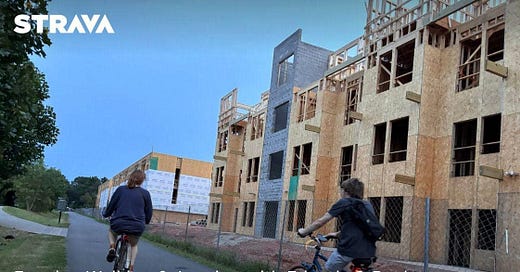I Have Become Obsessed with Strava
How the fitness app can be used to encourage active transportation
So this blog post was originally titled “So This Week I Have Become Obsessed with Strava”, but I ended up dropping the first part because this is one of the posts that got delayed by Hurricane Helene and my role in responding to that crisis on my campus. I am circling back around to this because I do have a lot of fun logging my walking commutes on this app that is primarily for fitness. It is my belief that this app provides opportunities to encourage folks to engage in active transportation activities. If you join Strava after reading this, be sure to request to follow me on there under the name ‘Livvy the Walking Spartan’!
The screenshot from Strava above is from a a little trip down the rail trail with friends. While they were on their bikes, I did my best to keep up with my feet. This was also my longest single log of Strava for awhile until I beat it with a grocery trip to the Ingles. As stated in the introduction, Strava is primarily a fitness app, boasting a wide array of log-able activities. These include everything from skiing to weight training to jogging to pickleball. Even within cycling, they allow you to log everything from a gravel ride to an e-bike ride.
This blog will always be free, but if you want to support the work that I do with a tip, feel free to use the button below!
For the longest time I had knew of the app but never downloaded because I thought that the fitness aspect was its sole utility. I heard of other urbanists using it who were cyclists, so I assumed it served that purpose. In this current season of my life, I walk far more than I get to cycle so I assumed the app would not serve much of a purpose for my active transportation lifestyle. I had given an old bike of mine to my friend Nate and they started logging on Strava, which is when I tried it out myself.
I have since used it pretty religiously. If I embark on any walk I anticipate will be longer than 10 minutes, I go ahead and log it. I recently hit my 150th logged activity, and funnily enough it was also logged with Nate and Sarah.
For me, it is fun to be able to log these activities and add notes, photos, and videos. I also like seeing the activities by some of my friends, including Dr. Julie Jones who I convinced to get Strava. I love this and it makes me want to get out more.
Strava & Active Transportation Advocacy
Now you may wonder how this fitness app that is popular with run clubs can help advocate for better and safer infrastructure for pedestrians. A 2014 Streetsblog post by Tanya Snyder discusses how Strava’s heatmaps allow cities and advocacy organizations to see where people walk and bike the most and least. Now, this data is obviously skewed because it is based on people logging their activities on Strava, but it can be a good way to collect data.
This data can be a useful baseline for advocacy organizations to leverage. On one hand, data showing a street has a lot of walking and biking activity can be used to argue for improved infrastructure. This could mean adding a track like the Hub City Hopper in addition to the sidewalk. For streets within a city that have less logged activity, this could be a sign that improvements are necessary, especially if the route represents a gap in the network that is a barrier to people walking and cycling. For example, the intersection of Pine Street and East Main Street is often a barrier for Converse University students and the residents in surrounding neighborhoods to accessing the downtown core by foot or by bike.
There are other ways to collect data for trail usage, but I still believe that Strava can be a great tool, whether you are an advocate or just want to be able to get out more and exercise.
In closing, I encourage you to download Strava, add me on there, and give the app a try!







Fun! I use Garmin for similar reasons, so consider adding that data as well for any advocacy work.